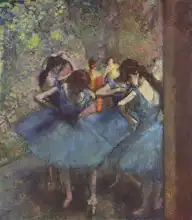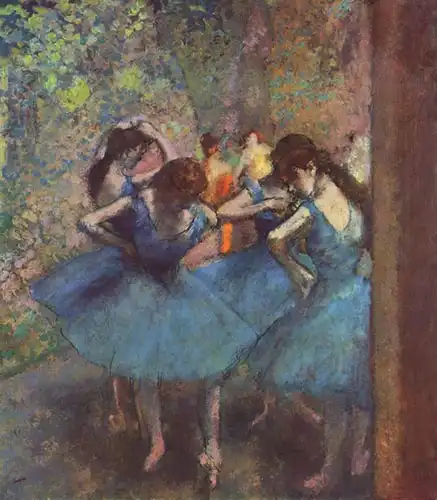About this finishing
Print. The image is printed on the top quality 10-ink HP Z9PS printer on HP matte 270 g / m2 paper. You can choose any size to an accuracy of 1 cm. A margin of 5 cm around the image is added to the size of the motif.


You can find a detailed description about our finishings
here.
Danseues bleues
Date:
1895Medium:
oil on canvasLocation:
Musee d'Orsay, Paris, France"Danseuses bleues" (Blue Dancers) is an oil painting by the French
Impressionist artist
Edgar Degas , created around 1899. This work is one of his many paintings depicting female dancers and ballet performances. The painting shows two female dancers standing next to each other. Their characters are elegant and appear in dancing costumes. The title of the painting suggests that the
dancers are dressed in blue costumes. Blue is a prominent color in this image and creates a strong contrast to the other tones. The dancers wear dance costumes with tulle skirts that extend in a circle around them. They also wear elegant dancing hats that add delicacy and elegance to their figures.
The background of the image is simple and abstract. Degas focused on capturing the dancers themselves and their movement, rather than a specific scenario or setting. The image captures the impression of movement and dynamism. Degas often specialized in depicting female dancers as they performed their movements and exercises. Degas was part of the Impressionist movement and this can be seen in his use of light and color which changes the impression from different viewing angles. Degas was a master at capturing moments and movement in art. This painting shows the dancers at the moment of their performance.
Degas painted picture Danseues bleues in 1895. Prevailing color of this fine art print is blue and its shape is portrait. This art piece is located in Musee d'Orsay, Paris, France. This image is printed on demand - you can choose material, size and finishing.
Edgar Degas (1834-1917). French painter and sculptor. He is considered one of the founders of
Impressionism, although he called himself a
realist. As an 1870s painter associated with dance, over half his works are devoted to depicting ballerinas, ballet performances and practices. His portrayal of motion is one of the most perfect seen. He also devoted himself to portraiture, and his portraits and nudes are among the most admired in history.


